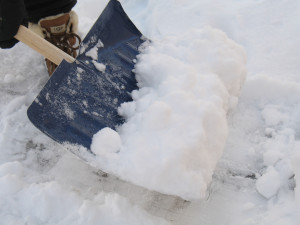 Snow was as appealing to me as to any kid growing up in the Chicago suburbs. In those pre-Internet days we huddled eagerly around the radio, listening to the long list of school districts that had canceled classes. In memory, at least, ours closed down only rarely, but when it did, that was occasion for celebration.
Snow was as appealing to me as to any kid growing up in the Chicago suburbs. In those pre-Internet days we huddled eagerly around the radio, listening to the long list of school districts that had canceled classes. In memory, at least, ours closed down only rarely, but when it did, that was occasion for celebration.
And then we’d have to go shovel the damn driveway.
Which was long—the lots and lawns were big back there, our house set particularly far back from the street, and we had one of those elaborate semicircular driveways that ensured you never had to back out.
Other parents might have allowed that yes, it was OK to ignore the longer part of the semicircle on heavy snow days—other people managed to back out of their driveways, after all—but our dad with German meticulousness insisted that the whole thing be wholly shoveled, every time. I think it wasn’t until I reached high school age—and the Chicago area suffered two or three big snow years in a row—that he got a snowblower to help with the whole affair.
So there we were, three kids, two adults, shoveling a seemingly endless expanse of asphalt, not so sure anymore that this snow thing was such a good idea.
The suburbs were well to do. Most of the neighbors hired some guy with a pickup to plow out their driveway. Some didn’t even bother, trusting instead in the quality of their snow tires—they really earned my father’s scorn. A whole family out clearing a huge driveway with a motley collection of snow shovels was … weird.
It was Mrs. Olson who gave me at least one solid purpose in shoveling. She lived two houses down in a sturdy Colonial, and every time I ever saw her she had her white hair curled up in a tight bun. She looked ancient and ageless all at the same time. She’d lost her husband some time before. To me she seemed old enough that I half-thought he must have been the captain of one of the sailing ships whose paintings graced her living room—which she probably called her parlor, or sitting room.
So one white morning I found myself nervously ringing her bell asking if I could shovel her driveway.
For money. It was my first job.
I could, she said, smiling sweetly.
I had to wait until after the home driveway was done, but from then on I’d shovel eagerly, knowing that once ours was done I could head over to Mrs. Olson’s refreshingly short, straight-shot driveway, knowing that after I was done she’d invite me into her small warm kitchen for thin gingersnaps and hot chocolate, knowing that she’d each time pay me a munificent fee—five dollars, I think, which went a lot farther back then than it does now.
It’s funny the way priorities and pleasures both change. Now I live on the side of a hill in Flagstaff and love shoveling for nothing. It’s because as a keyboard worker I love the physical activity. It’s because Flagstaff snow is spectacularly beautiful, so often illuminated by warming sun and shocking blue sky rather than Midwestern grey. It’s because we usually take the trouble to pile all the snow from the sidewalk onto our single tiny patch of lawn, the better to create a giant snow fort for the 10-year-old.
But mainly it is the democracy of snow shoveling that thrills me. We see more of our neighbors after a heavy snow than on the most beautiful summer evening. There’s our great friend across the street out shoveling her walk—we’ll go help her with the berm the grader piled up during the night. There’s one of the local teenagers helping a neighbor push an inadequate front-wheel-drive car from the parking spot where it’s gotten stuck. There’s the neighbor from down the block who I haven’t talked to a great deal, but we can all trust that he’ll walk up and down the block with his snowblower, clearing the sidewalk of anyone who hasn’t shoveled it yet.
Most of the driveways are short, and I don’t know anyone of the neighbors who hires the work out. Snow shoveling: community in action.
My dad would have liked it too. He’d have liked seeing so many folks engaged in vigorous outdoor activity. He’d have appreciated the tidiness and the sense of completion. And he’d have loved the way that nature and human action so clearly go hand in hand in the Flagstaff climate.
He might have viewed it as a sort of moral judgment.
What I mean is this: if you clear your sidewalk in Flagstaff, the sun will almost inevitably come out and dry off the pavement. If you don’t, the pounded-down snow will melt and refreeze and melt and refreeze and result in the most interesting and treacherous combinations of ice.
The payoff is clear. Our job is clear. And if we perform it right, so is the sidewalk.

